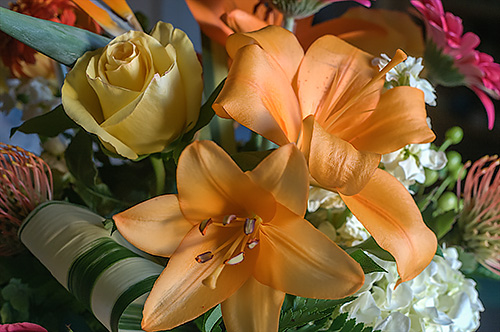Photo Corners headlinesarchivemikepasini.com
![]()
A S C R A P B O O K O F S O L U T I O N S F O R T H E P H O T O G R A P H E R
![]()
Enhancing the enjoyment of taking pictures with news that matters, features that entertain and images that delight. Published frequently.
That Bouquet At Sunset




3 November 2014
The sunsets this time of year can be spectacular with various cloud formations performing nightly. They're also spectactularly difficult to capture. So we were happy to see the light of the setting sun falling on the bouquet of flowers we highlighted in our Friday Slide Show.

We used the same camera and lens, a Nikon D300 with a 50mm f1.4 Nikkor. But this time the light was all from the sun and the camera hand-held at f5.6, 1/60 second and ISO 400.
That's not the only difference between this shot and Friday's slide show.
We wanted to experiment with a workflow that might include Piccure+ and what we learned about it in our discussion with Lui.
And we say "experiment" for a reason.
The DNG preview was very dark, almost black. We didn't want to work with that in Piccure+ because we wouldn't be able to evaluate the preview.
If you have any doubts that you're living in the Golden Age of Photography, this should help resolve them.
But because it's a DNG, we could open it in Adobe Camera Raw (via Photoshop) and make a few adjustments that would be saved to the DNG. After we optimized the color and tone of the image, we simply opened it in Photoshop and quit without saving. ACR had already recorded the edits within the DNG.
Had we been working on the original NEF, that would have been in a sidecar.
Piccure+ seemed to read those adjustment (or at least the updated thumbnail) so we had a better image to work with. We used Quality+, Strong Optical Aberrations, slightly lower Sharpening and a touch of De-Noising and let it fly.
We liked the edited image in Camera Raw. It had all the drama of sunset lighting we had hoped to capture, quite different from the strobe-illuminated shots on Friday, as you can see above.
But the Piccure+ image was almost three dimensional. We actually had to undo a few of our Camera Raw edits when we brought the TIFF into Camera Raw to finish it off.
If you have any doubts that you're living in the Golden Age of Photography, this should help resolve them. Not only do we have captures that record more data than can be displayed but we have software that can mine that data to produce stunning images.
Whether it's working in 32-bit color space with HDR Expose or correcting lens compromises with Piccure+ or eliminating noise with DxO OpticPro's PRIME or fine-tuning an image with Adobe Camera Raw in Photoshop or Lightroom, we're doing things with images that we've never been able to do before.
Bouquets to the people who are making it all possible!